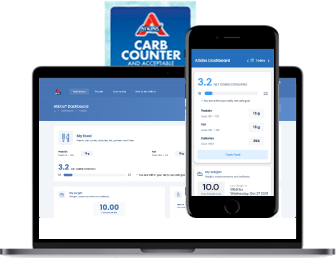Glossary
Aerobic exercise: Sustained rhythmic exercise that increases your heart rate; also referred to as cardio.
Amino acids: The building blocks of protein.
Antioxidants: Substances that neutralize harmful free radicals in the body.
Atherosclerosis: Clogging, narrowing, and hardening of blood vessels by plaque deposits.
Atkins Carbohydrate Equilibrium (ACE): The number of grams of Net Carbs that a person can consume daily without gaining or losing weight.
Atkins Edge: A beneficial state of fat-burning metabolism, caused by carbohydrate restriction, that makes it possible to lose weight and maintain weight loss without extreme hunger or cravings; a metabolic edge.
Beta cells: Specialized cells in the pancreas that produce insulin.
Blood lipids: The factors of total cholesterol, triglycerides, and HDL and LDL cholesterol in your blood.
Blood pressure: The pressure your blood exerts against the walls of your arteries during a heartbeat.
Blood sugar: The amount of glucose in your bloodstream; also called blood glucose.
BMI: See Body mass index.
Body mass index (BMI): An estimate of body fatness that takes into account body weight and height.
Carbohydrate: A macronutrient from plants and some other foods broken down by digestion into simple sugars such as glucose to provide a source of energy.
Cholesterol: A lipid; a waxy substance essential for many of the body’s functions, including manufacturing hormones and making cell membranes.
C-reactive protein (CRP): A chemical in blood that serves as a marker for inflammation.
Diabetes: See Type 1 diabetes and Type 2 diabetes.
Diuretic: Anything that removes fluid from the body by increasing urination.
Essential fatty acids (EFAs): Two classes of essential dietary fats that your body cannot make on its own and that must be obtained from food or supplements.
Fat: One of the three macronutrients; an organic compound that dissolves in other oils but not in water. A source of energy and building blocks of cells.
Fatty acids: The scientific term for fats, which are part of a group of substances called lipids.
Fiber: Parts of plant foods that are indigestible or very slowly digested, with little effect on blood glucose and insulin levels; sometimes called roughage.
Foundation vegetables: Leafy greens and other low-carbohydrate, nonstarchy vegetables suitable for Phase 1 and Induction, and the basis upon which later carb intake builds.
Free radicals: Harmful molecules in the environment and naturally produced by our bodies. Excess free radicals can damage cells and cause oxidation.
Glucose: A simple sugar. Also see Blood sugar.
Glycogen: The storage form of carbohydrate in the body.
HDL cholesterol: High-density lipoprotein; the “good” type of cholesterol.
Hydrogenated oils: Vegetable oils processed to make them solid and improve their shelf life. See Trans fats.
Hypertension: High blood pressure.
Inflammation: Part of the body’s delicately balanced natural defense system against potentially damaging substances. Excessive inflammation is associated with increased risk of heart attack, stroke, diabetes, and some forms of cancer.
Insulin: A hormone produced by the pancreas that signals cells to remove glucose and amino acids from the bloodstream and stop the release of fat from fat cells.
Ketoacidosis: The uncontrolled overproduction of ketones characteristic of untreated type 1 diabetes, typically five to ten times higher than nutritional ketosis.
Ketones: Substances produced by the liver from fat during accelerated fat breakdown that serve as a valuable energy source for cells throughout the body.
Ketosis: A moderate and controlled level of ketones in the bloodstream that allows the body to function well with little dietary carbohydrate; also called nutritional ketosis.
LDL cholesterol: Low-density lipoprotein. Formerly known as the “bad” type of cholesterol, but not all LDL cholesterol is “bad.” Lean body mass: Body mass minus fat tissue; includes muscle, bone, organs, and connective tissue.
Legumes: Most members of the bean and pea families, including lentils, chickpeas, soybeans, peas, and numerous others. Lipids: Fats, including triglycerides, and cholesterol in the body.
Macronutrients: Fat, protein, and carbohydrate, the dietary sources of calories and nutrients.
Metabolic syndrome: A group of conditions, including hypertension, high triglycerides, low HDL cholesterol, higher-than-normal blood sugar and insulin levels, and weight carried in the middle of the body. Also known as syndrome X or insulin resistance syndrome, it predisposes you to heart disease and type 2 diabetes.
Metabolism: The complex chemical processes that convert food into energy or the body’s building blocks, which in turn become part of organs, tissues, and cells.
Monounsaturated fat: Dietary fat typically found in foods such as olive oil, canola oil, nuts, and avocados.
Net Carbs: The carbohydrates in a food that impact your blood sugar, calculated by subtracting fiber grams in the food from total grams. In a low-carb product, sugar alcohols, including glycerin, are also subtracted.
Omega-3 fatty acids: A group of essential polyunsaturated fats found in green algae, cold-water fish, fish oil, flaxseed oil, and some other nut and vegetable oils.
Omega-6 fatty acids: A group of essential polyunsaturated fats found in many vegetable oils and also in meats from animals fed corn, soybeans, and certain other vegetable products.
Partially hydrogenated oil: See Trans fats.
Personal Carb Balance: The number of grams of Net Carbs that one can consume daily without gaining or losing weight.
Plaque: A buildup in the arteries of cholesterol, fat, calcium, and other substances that can block blood flow and result in a heart attack or stroke.
Polyunsaturated fats: Fats with a chemical structure that keeps them liquid in the cold; oils from corn, soybean, sunflower, safflower, cottonseed, grape seed, flaxseed, sesame seed, some nuts, and fatty fish are typically high in polyunsaturated fat.
Prediabetes: Blood sugar levels that are higher than normal but fall short of full-blown diabetes.
Protein: One of the three macronutrients found in food, used for energy and building blocks of cells; chains of amino acids.
Resistance exercise: Any exercise that builds muscle strength; also called weight-bearing or anaerobic exercise.
Satiety: A pleasurable sense of fullness.
Saturated fats: Fats that are solid at room temperature; the majority of fat in butter, lard, suet, palm and coconut oil.
Statin drugs: Pharmaceuticals used to lower total and LDL cholesterol.
Sucrose: Table sugar, composed of glucose and fructose.
Sugar alcohols: Sweeteners such as glycerin, mannitol, erythritol, sorbitol, and xylitol that have little or no impact on most people’s blood sugar and are therefore used in some low-carb products.
Trans fats: Fats found in partially hydrogenated or hydrogenated vegetable oil; typically used in fried foods, baked goods, and other products. A high intake of trans fats is associated with increased heart attack risk.
Triglycerides: The major form of fat that circulates in the bloodstream and is stored as body fat.
Type 1 diabetes: A condition in which the pancreas makes so little insulin that the body can’t use blood glucose as energy, producing chronically high blood sugar levels and overproduction of ketones.
Type 2 diabetes: The more common form of diabetes; high blood sugar levels caused by insulin resistance, an inability to use insulin properly.
Unsaturated fat: Monounsaturated and polyunsaturated fats.

